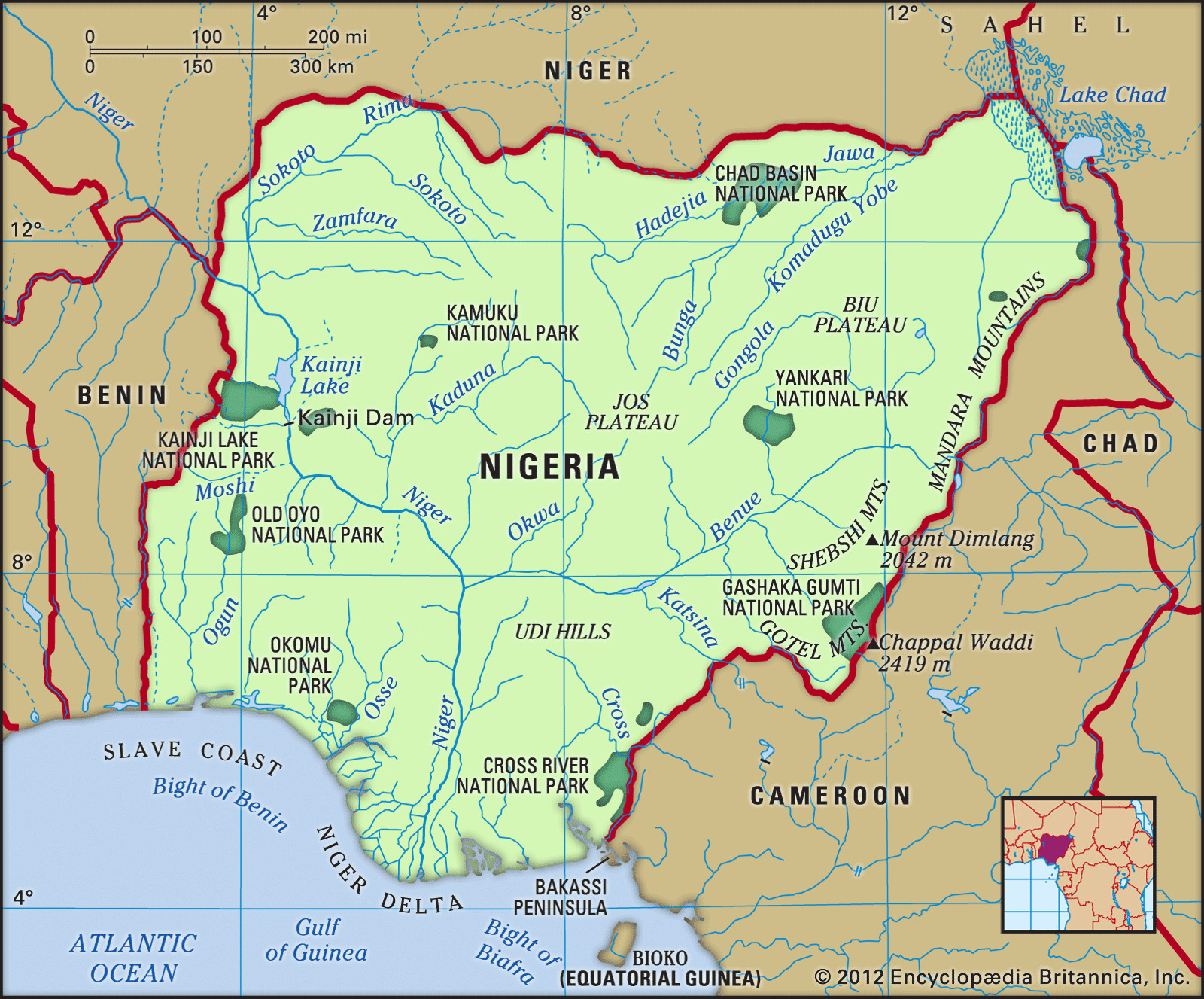 Map of Nigeria highlighting its location in Africa
Map of Nigeria highlighting its location in Africa
Nigeria, officially known as the Federal Republic of Nigeria, is situated in West Africa, specifically on the continent’s western coast. To pinpoint exactly Nigeria Where Is It, it’s geographically positioned north of the equator and west of the prime meridian. Nigeria shares land borders with several countries: Niger to the north, Chad and Cameroon to the east, and Benin to the west. Its southern boundary is defined by the Gulf of Guinea, which is part of the Atlantic Ocean. Often referred to as the “Giant of Africa” due to its large population and economy, Nigeria is a country of significant size, exceeding even the state of Texas in the United States in land area. It holds the distinction of being the most populous nation in Africa, making its geographical location and diverse landscape all the more important to understand.
Diverse Topography and Relief
The landscape of Nigeria presents a varied topography, generally characterized by plains in both the northern and southern regions. These plains are interrupted by plateaus and hills that rise in the central parts of the country, creating a diverse geographical profile. In the northwest, you’ll find the Sokoto Plains, while the Borno Plains dominate the northeast, stretching towards the Lake Chad basin. These areas, along with the coastal zones and the Niger River delta, are built upon young sedimentary rocks, resulting in gently rolling plains that are prone to waterlogging during the rainy seasons.
Moving towards the plateaus, the terrain shifts to high plains interspersed with broad, shallow valleys. Distinctive landforms here include numerous hills and isolated mountains known as inselbergs. The geology of these plateaus is primarily crystalline rock, although sandstone formations appear in river valleys. Notably, the Jos Plateau stands almost at the country’s center, a vast expanse of lava surfaces marked by extinct volcanoes. Other elevated terrains, like the Udi-Nsukka escarpment, ascend sharply from the plains, reaching elevations of at least 1,000 feet (300 meters). For the most dramatic mountainous scenery, look to Nigeria’s southeastern border with Cameroon. Here, the Cameroon Highlands feature the country’s highest points: Chappal Waddi in the Gotel Mountains and Mount Dimlang in the Shebshi Mountains.
Major Drainage Systems
Nigeria’s water systems are defined by three principal drainage basins: the Niger-Benue basin, the Lake Chad basin, and the Gulf of Guinea basin. The Niger River, from which Nigeria derives its name, and its largest tributary, the Benue River, are the dominant rivers. While the Niger River is characterized by rapids and waterfalls, the Benue is navigable throughout most of its course, except in the dry season. North of the Niger-Benue trough, rivers like the Sokoto, Kaduna, and Gongola flow, eventually draining into Lake Chad. The coastal regions are served by shorter rivers that empty into the Gulf of Guinea. Human intervention has shaped Nigeria’s water landscape with river basin development projects creating large man-made lakes such as Lake Kainji on the Niger River and Lake Bakolori on the Rima River.
The Niger Delta is a significant geographical feature, a sprawling low-lying region where the Niger River’s waters flow into the Gulf of Guinea. This delta is characterized by oxbow lakes, river meander belts, and prominent levees. The landscape transitions from large freshwater swamps to brackish mangrove forests closer to the coastline, showcasing a unique ecological zone.
Soil Composition and Agricultural Use
Nigerian soils, typical of African soils in general, are often less fertile compared to those in other parts of the world. Historically, Nigerian farmers have adapted to these conditions using agricultural techniques like slash and burn, intercropping, and shallow planting tools. These methods allowed precolonial Nigeria to produce enough food for its population and even generate surpluses for export.
Nigeria’s soil zones are closely linked to its geographical regions. In the north, loose sandy soils, composed of wind-borne deposits and river sands, are prevalent. However, in areas with distinct dry seasons, a hard laterite surface layer can develop, making cultivation challenging. Conversely, the soils in the northern states of Kano and Sokoto are more easily farmed due to less leaching. Moving south from Kano, mixed soils containing granite and loess are found. The savanna regions, encompassing the middle two-thirds of Nigeria, are characterized by reddish laterite soils, which are moderately fertile but less so than the northern soils due to differences in seasonal drying and rainfall. The forest soils in the south represent the most agriculturally productive zone. Here, vegetation provides humus and protects against erosion from heavy rainfall, although these soils are susceptible to leaching. Hydromorphic and organic soils, largely confined to coastal sedimentary rock areas and river floodplains, represent the youngest soil types in Nigeria.
